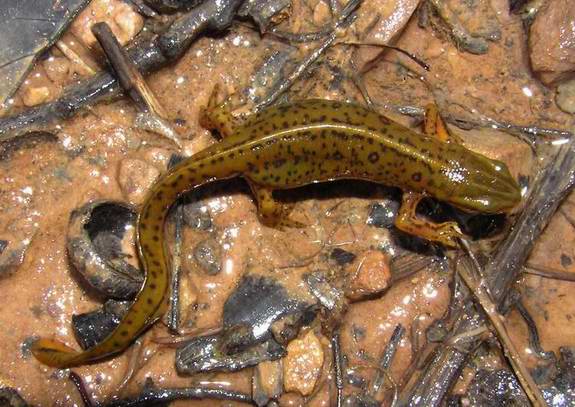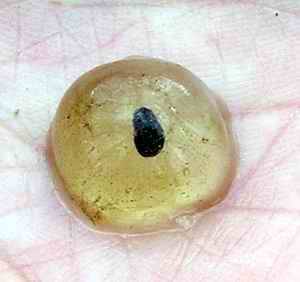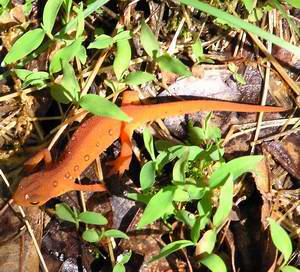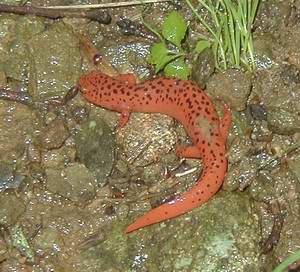|
Return to Hiker's Notebook Home Page
Common Name: Red-Spotted Newt - The name newt is a solecism of the Old English word efete which now refers to the frequently seen terrestrial phase of the salamander abbreviated to 'eft' in Modern English. Over time efete evolved to ewte, which became "an ewte" which was concatenated to 'newt' over time. It has notably visible red spots by which it is further identified and mnemonically described as red-spotted.
Scientific Name: Notophthalmus viridescens viridescens - The generic name is likely derived from the Greek ophthalmos, meaning eye, and may be a reference to the eye-like red spots on the dorsal surface of both the adult and juvenile forms. The first species name is derived from the Latin viridis, meaning green, the predominant color of the adult newt. The second species name is to distinguish the Red-Spotted Newt from the other three closely related Eastern Newts. Sometimes listed as Diemictylus viridescens.
Newts are the predominant members of the family Salamandridae commonly known as salamanders and are traditionally considered to be those members of the family that are aquatic. They are further distinguished by having three distinct forms in metamorphosing from aquatic larvae to juvenile terrestrial quadrupeds called efts and culminating the life cycle as aquatic and/or terrestrial adults. In eastern North America, adult newts are primarily aquatic with some allowance for terrestrial migrations to account for environmental stress whereas in western North America and Europe, adult newts are terrestrial. All adult newts breed in water. Whereas most salamanders are viscid and have prominent indentations called costal grooves along their sides , the newts have relatively rough skin and no costal grooves. The salamandrid life cycle begins with the hatching of an egg in the early spring that was laid and individually wrapped in a protective covering of decaying leaves or other pond detritus by the assiduous female adult newt. The voraciously carnivorous larvae have prominent finned tails and external gill tufts. They feed on small pond invertebrates for several months before moving to one end of the pond in preparation for metamorphosis which occurs from late June in Maryland to mid-August in Virginia. The resultant juvenile red eft is a fully transformed terrestrial lizard-like quadruped with lungs.
The reason for the eft migratory stage is subject to some conjecture since some newt species do not have an eft stage at all, and for those that do, there is significant geographic variance in its duration. The relative environmental distress levels of the aquatic and terrestrial habitats is one migration hypothesis. Pond desiccation would promote the metamorphosed land-dwelling eft stage and mandate relocation. Conversely, the loss of terrestrial habitat would favor the aquatic Palladium, to the point where the larvae remain aquatic and metamorphose directly to adults. The variation in the duration and extent of the newt to eft transformation has long been studied based on observations of neoteny (the retention of juvenile features) in the adult newt. Neotenic adults retain remnants of the external gills and gill slits of the larval stage and appear in areas where loss of terrestrial habitat results in a diminution of the eft stage. It was first noted in areas around New York City in 1886 and has since been found endemic in sandy areas with compromised terrestrial habitats. The loss of aquatic habitats has likewise been found to have the reverse effect; a study in 1970 found that a population of neotenic adults reverted nearly universally to the eft stage after a few years during which drought conditions prevailed. A second hypothesis is the dispersal theory, that efts migrate to expand their populations to new habitats. This is suggested by the observation that males migrate earlier and in more dense groupings than the females. One noted observation in Massachusetts in 1938 recorded the migration of thousands of efts which were so concentrated that 1200 were collected in a single 5 square meter area. What is clear is that the red-spotted newt is highly adaptable in its ability to counteract environmental changes with a countervailing metamorphosis variance in the extent and duration of the eft stage.
Like the vibrantly colorful butterflies, the almost iridescent and
defenseless red eft raises questions about its survivability in the predatory
forest habitat. The orange-red dorsal pigmentation is aposematic, a term which
refers to the use of structures or colors by an animal to provide a facile
visual identification as a means of defense. In the case of the red eft, the
red is a warning to predators of its toxicity. The skin of the red-spotted
newt contains the neurotoxin tetrodotoxin, which becomes concentrated by a
factor of ten in the eft stage relative to the adult and is found primarily on
the dorsal surface, both factors which address the eft's terrestrial
vulnerability; the adult viridity affords some camouflage in the murky waters
of the pond to offset the loss of the visual cue. The effectiveness of the
toxin on potential predators has been thoroughly studied;
American toads and brook trout die
within hours of being force fed red efts.
Garter snakes,
crayfish and beetle larvae have all been
observed to suffer from agitation of their various diverse mouth parts when
eft consumption is attempted. Predators survive according to experience, and
most therefore avoid the
The red-spotted newt is capable of returning to a specific location even when removed artificially so that there is no means to establish landmarks, a capacity known as true navigation requiring both map sense and compass sense. The former refers to the overall orientation of the current position to the destination and the latter refers to the direction to be followed. Though the homing instinct has been demonstrated in field experiments, an understanding of the mechanism employed in its execution is lacking; it is thought to involve the use of the earth's magnetic fields, a magnetoreceptive capability. The homing instinct is necessary for the partially migratory adult newt to get back to the home pond to mate. The adult male locates a female and holds her in an embrace called an amplexus for as long as several hours, releasing a spermatophore into the water at the climax. The female takes up the sperm mass in her cloaca for internal fertilization, and, soon after mating, proceeds to the protected area of the pond to lay up to 400 individually wrapped eggs over several weeks. And the salamandrid life cycle goes on. |


 The
peripatetic red eft is diurnal and normally appears after rains due to its
preference for humid conditions. Field experiments have found that an eft
stays within 800 meters of its natal pond and establishes a home range area of
about 300 square meters; marked individuals have been found at nearly the
exact same location from one season to the next. The eft stage lasts from 4 to
7 years with shorter durations prevailing in southern regions. Like their
larval predecessor stage, the juvenile salamanders are significant carnivores,
consuming vast quantities of springtails (small wingless insects of the order
Collembola) during their rain-induced forays.
The
peripatetic red eft is diurnal and normally appears after rains due to its
preference for humid conditions. Field experiments have found that an eft
stays within 800 meters of its natal pond and establishes a home range area of
about 300 square meters; marked individuals have been found at nearly the
exact same location from one season to the next. The eft stage lasts from 4 to
7 years with shorter durations prevailing in southern regions. Like their
larval predecessor stage, the juvenile salamanders are significant carnivores,
consuming vast quantities of springtails (small wingless insects of the order
Collembola) during their rain-induced forays.  red eft; those that successfully do prey on the toxic efts practice
decapitation and evisceration as a means of avoiding the toxic skin. Because
all predators are not deterred, the red eft has an instinctual backup response
known as the Unken reflex. When attacked, the eft will arch its back to expose
its more brightly colored ventral surface and rigidly hold the arched-back
position to reduce predator stimulating movements. The coloration of the red
eft is so strong a deterrent that several other salamanders, notably the red
salamander (Pseudotriton ruber), employ mimicry to emulate the
resultant protection. Tactile contact with the tetrodotoxin skin secretion is
harmless to humans, though ingestion would probably result in some distress.
red eft; those that successfully do prey on the toxic efts practice
decapitation and evisceration as a means of avoiding the toxic skin. Because
all predators are not deterred, the red eft has an instinctual backup response
known as the Unken reflex. When attacked, the eft will arch its back to expose
its more brightly colored ventral surface and rigidly hold the arched-back
position to reduce predator stimulating movements. The coloration of the red
eft is so strong a deterrent that several other salamanders, notably the red
salamander (Pseudotriton ruber), employ mimicry to emulate the
resultant protection. Tactile contact with the tetrodotoxin skin secretion is
harmless to humans, though ingestion would probably result in some distress.